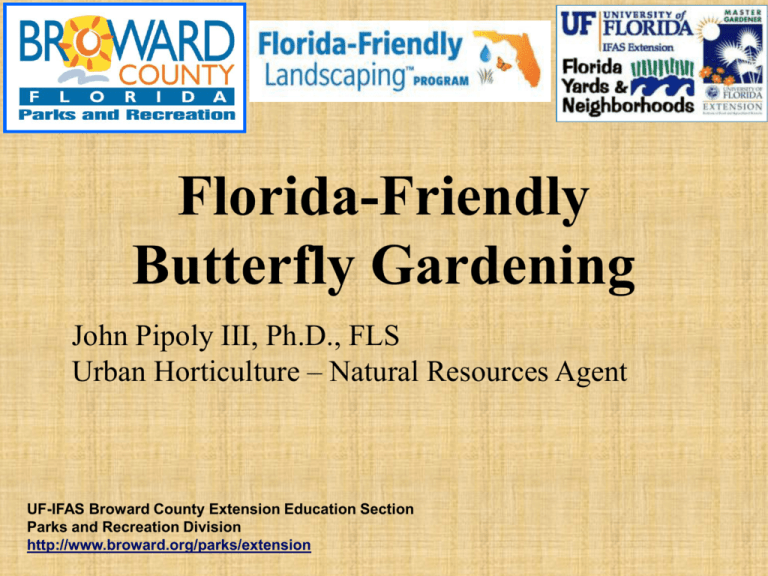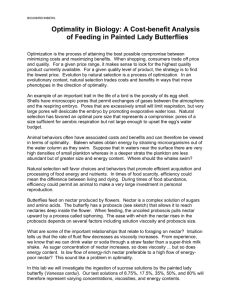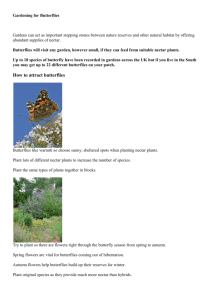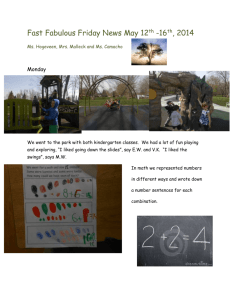Florida-Friendly Butterfly Gardening
advertisement

Florida-Friendly Butterfly Gardening John Pipoly III, Ph.D., FLS Urban Horticulture – Natural Resources Agent UF-IFAS Broward County Extension Education Section Parks and Recreation Division http://www.broward.org/parks/extension Anatomy of the Butterfly Antennae Multifaceted Eye Forewing Proboscis Leg Smells with antennae Hind wing Smells and tastes with feet Straw-like mouthpart used to sip nectar The wings are covered with scales • Sees broader spectrum of color including ultraviolet Life Cycle of the Butterfly Adult Chrysalis stage lasts 10 to 15 days Life span varies among species. Within a species, life span may also depend upon latitude, time of year, and even local weather conditions. Adult lasts from 1 week to 6 months; feeds on nectar from flowers Chrysalis (pupa) Egg Larva Egg takes from 5 to 10 days to hatch Larva grows from 2 to 6 weeks before pupation into chrysalis. Eats leaves and stems of larval plants What is a Larval Plant? Plant where butterflies lay their eggs and the (larvae) caterpillars eat the leaves and stems for food What is a Nectar Plant? Plant that feed adult butterflies with nectar from the flowers The flowers may be pollinated by the butterflies Why is the Larval Plant Eaten? Why is the Nectar Plant not harmed? The caterpillar has mouthparts that chew The adult butterfly drinks nectar from the flowers and has siphoning or sucking mouthparts like a straw Butterfly Requirements Shelter (Large plants to hide in inclement weather) Safe sunny area away from human traffic Food (Larval and Nectar Plants) and water A place to raise young (Larval or Host Plants) Puddling Station Butterfly Garden Design Background Plantings Wild Lime- Zanthoxylum fagara Larger tree Butterfly Garden Design Background Plantings Firebush- Hamelia patens Larger shrub Butterfly Garden Design Middle Area Medium shrubs Medium shrubs Golden Dew Drop- Duranta erecta Atala on FiddlewoodCitharexylum spinosum Medium shrubs Medium shrubs Medium shrubs Butterfly Garden Design Foreground Area Native Porter Weed, Stachytarpheta jamaicensis Small plants Small plants Small plants Butterfly Garden Design Skipper larva on Canna Foreground Area Small plants Small plants Small plants Monarch on Asclepias tuberosa You do not need a lot of space to have a butterfly garden. Plant in blocks of analagous color -adjacent on color wheel (e.g., red + blue) Tropical Sage: Salvia coccinea Sky Blue Salvia Salvia azurea Is Space a Problem? Try Gardening in Bags Grow bags are far superior to standard pots • Be sure you have some host and nectar plants. • Be sure it is in a less traveled area. • Have a water source. Nectar Plants in Your Garden Nectar Flowers in Your Garden Lantana – Lantana depressa – low native, mat-forming shrub with yellow flowers --Lantana involucrata low native shrub with white flowers Nectar Flowers in Your Garden The native porterweed is a short plant that can be used for a border plant and grows to 2 foot in height, in full sun Native Porterweed Stachytarpheta jamaicensis Be sure to double check– our native species S. jamaicensis is often confused with the exotic S. cayennensis. S. jamaicensis’ flowers should be violet-blue (not mauve or white), with floral bracts 2 mm (not 1 mm) broad Nectar Flowers in Your Garden ‘Pentas’ Pentas lanceolata of the Coffee Family (not native but not invasive) • Small to medium sized short lived perennial (about 3 years) attaining heights from 18 inches to 5 feet depending on variety and color • Likes full to partial sun How to “Dead-head”- remove old flowers Pentas will bloom more often and other annuals live longer when they are dead-headed Nectar Flowers in Your Garden ‘Blue ‘Tropical Sage' Salvia coccinea or Azurea Sage' Salvia azurea Lamiaceae Nectar Flowers in Your Garden White Twine or White Milkweed Vine Sarcostemma clausum Twining vine with milky sap Likes full to light shade Small white flowers Giant Milkweed Calotropis procera Herbaceous plant growing 8-12 ft tall Lavender flowers Likes full Sun Attracts butterflies for nectar or larva More nectar plants Monarchs LOVE our native milkweed, Asclepias tuberosa Asclepias currassavica, the Scarlet Butterfly Weed, is invading our natural areas and is not recommended Nectar Plants for your Garden: Sea Lavender Tournefortia gnaphaloides Boraginaceae Nectar for Queen Butterfly Danaus gilippus Nectar plants for your garden Railroad Vine Ipomoea pes-caprae Convolvulaceae Nectar plant for Gulf Fritillary Agraulis vanillae Nectar Flowers in Your Garden Firebush Hamelia patens- one polymorphic species Attracts butterflies and hummingbirds DO NOT WORRY IF YOU HAVE THE COMPACT FORM !!!! It is actually more sustainable than the other forms LARVAL PLANTSCaterpillars will often severely defoliate plants- That is their purpose.. Do not worry Saw palmetto Serenoa repens Arecaceae Larval Host for Palmetto Skipper Euphyes arpa Native Strangler Fig, Ficus aurea, Moraceae Larval Host for Ruddy Daggerwing Marpesia petreus Larval plants for your garden Zamia integrifolia Coontie Zamiaceae, Larval plant for Atala butterfly Larval plants for your garden Atala mating Swamp Bay Persea palustris Lauraceae Larval Host for Palamedes Swallowtail Papilio palamedes Sand Pine Pinus clausa Pinaceae Larval Host for Pest: Subtropical pine tip moth Rhyacionia subtropica Larval Plants for your landscape Sand Live Oak- Quercus geminata Fagaceae Sand Live Oak: Larval Host for White M-Hairstreak Parrhasius m-album “Weeds” You might want to Cultivate Some weeds attract butterflies to collect nectar. Usually these weeds provide larval food, nectar sources, and a source of minerals for mating butterflies. A few of these can be cultivated in a butterfly garden but they need attention because they are aggressive and tend to spread if not controlled. Frogfruit or Matchweed Phyla nodiflora Frogfruit provides nectar and minerals. It will do well in shade or sun and in moist or dry areas. The only way you will obtain this plant is to volunteer to remove some weeds from a neighbors yard. Beggars tick or Spanish Needle Bidens alba Beggars tic provides nectar and minerals. Control can be achieved by deadheading and removal of new plants trying to increase their range. Water before dawn to avoid wetting emerging butterflies Be sure to AVOID the use of systemic pesticides in order not to kill the moths, skippers and butterflies in the garden. Neem oil will not kill butterflies, but it does disrupt the maturation process for caterpillars, therefore they will never live to reproduce and will die as caterpillars. Butterfly Gardening Information Butterfly Gardening in Florida http://edis.ifas.ufl.edu/uw057 Butterfly Garden Basics http://gardeningsolutions.ifas.ufl.edu/schoolgardens/school_ gardens/butterfly_garden.shtml Community Butterfly Scaping http://edis.ifas.ufl.edu/ep420 Get Started in Butterfly Gardening http://www.floridaplants.com/reprintbutter.html Butterfly Gardening- LadyBird Johnson Wildflower Center http://www.wildflower.org/howto/show.php?id=29 UF/IFAS Broward County Extension Education Section Parks and Recreation Division 3900 SW 100th Ave, Davie, FL 33328-1705 Phone: (954) 357-5270 A SERVICE OF THE BROWARD COUNTY BOARD OF COUNTY COMMISSIONERS Broward county programs are open to all persons regardless of race, color, religion, national origin, gender, age, disability or sexual orientation. Disabled individuals are requested to notify program two days prior to program an auxiliary aids if assistance is required. Disabled parking space and wheelchair ramp are available. An equal opportunity employer and provider of services. The Institute of Food and Agricultural Sciences (IFAS) is an Equal Opportunity Institution authorized to provide research, educational information, and other services only to individuals and institutions that function without discrimination with respect to race, creed, color, religion, age, disability, sex, sexual orientation, marital status, national origin, political opinions or affiliations, genetic information and veteran status as protected under the Vietnam Era Veterans' Readjustment Assistance Act. U.S. Department of Agriculture, Cooperative Extension Service, University of Florida, IFAS, Florida A&M University Cooperative Extension Program, and Boards of County Commissioners Cooperating.







